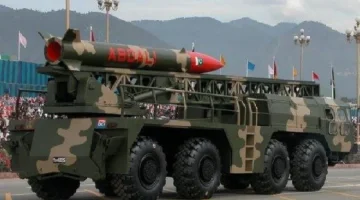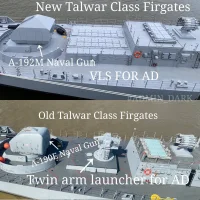- Views: 4K
- Replies: 18
India is developing a new conventional variant of its Agni-5 ballistic missile, designed as a "bunker buster" capable of destroying heavily fortified and deeply buried strategic targets.
According to reports, this formidable weapon is being engineered by the Defence Research and Development Organisation (DRDO) to carry a massive conventional warhead of up to 8,000 kg and penetrate as deep as 100 meters underground before detonation, marking a significant leap in the country's conventional military power.
This development addresses a critical gap in India's military arsenal: the absence of a dedicated long-range strategic bomber fleet.
The new Agni-5 variant is designed to serve as a cost-effective and survivable alternative, providing India with the capability to conduct deep-strike operations against high-value targets.
The project, reportedly initiated in mid-2025, is seen as a direct response to the evolving geopolitical landscape and the need to possess a credible deterrent against heavily fortified underground facilities maintained by potential adversaries.
The new missile represents a major evolution from its nuclear-capable predecessor, the Agni-5 Intercontinental Ballistic Missile (ICBM), which has a range exceeding 5,000 km.
To accommodate its exceptionally heavy payload, the bunker buster variant's range is reduced to approximately 2,500 km.
Its core strength lies in its ability to destroy hardened subterranean structures like command and control centres, underground nuclear storage sites, and missile silos.
This is achieved through a combination of a high-density, hardened penetrator casing and a delayed-action fuse, which allows the warhead to burrow deep into rock or reinforced concrete before exploding, maximizing damage to the target from within.
Travelling at hypersonic speeds between Mach 8 and Mach 20, the missile is extremely difficult to intercept.
Its survivability is further enhanced by its canister-based launch system, which allows it to be deployed from mobile road or rail platforms, making it hard to track and target.
The missile is guided by an advanced system integrating India’s indigenous NavIC satellite navigation and sophisticated ring laser gyroscopes for pinpoint accuracy.
A second variant with an airburst warhead is also reportedly in development to target surface assets like airfields and radar installations.
When compared to existing global systems, the Agni-5 bunker buster appears to be in a class of its own.
The United States’ premier weapon in this category, the GBU-57 Massive Ordnance Penetrator (MOP), is delivered by B-2 stealth bombers.
While the MOP bomb itself weighs over 13,600 kg, its explosive payload is a smaller 2,400 kg, and its maximum penetration is rated at around 60 meters of reinforced concrete.
The reliance on bombers also makes it vulnerable to advanced air defence systems.
Other international weapons, such as Russia's KAB-1500L-Pr and China's DF-15C, have far smaller payloads and significantly less penetration capability, estimated at around 20 meters.
The strategic implications of Agni-5 bunker buster for India’s defence posture are profound. It provides a powerful option for neutralizing critical enemy infrastructure, such as Pakistan’s reported Kirana Hills nuclear facility or China’s missile silos, without resorting to nuclear weapons.
This capability strengthens India's conventional deterrence and offers a credible pre-emptive strike option, fundamentally enhancing the nation's ability to manage regional security challenges.


